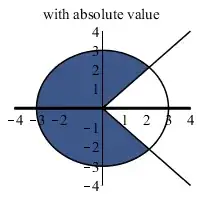The justification provided was "symmetry of the Normal", but as far as I understand it $Y$ is not equivalent to $\lvert Y \rvert$, most obviously because the supports are no longer the same!
My Spidey-senses seem to suggest that it has something to do with the interaction of the signs of $X$ and $Y$ (being symmetric), but I can't quite put my finger on it. Below is my attempt to make sense of it in my head.
Thinking aloud (to hopefully illustrate my confusion/rationalization):
Suspending disbelief that densities aren't probabilities for a second (for intuition's sake), the proposition states that the likelihood of every value $\frac{X}{Y}$ is the exact same for the corresponding $\frac{X}{\lvert Y \rvert}$ (that equals $\frac{X}{Y}$).
Let's take $\frac{X}{Y} = 1$ (for concreteness), the following two disjoint events qualify (for all $t$ in $[-\infty, \infty]$):
- $X = t, Y = t$
or
- $X = -t, Y = -t$
...but if $\frac{X}{\lvert Y \rvert}$, the likelihood of a $+t$ in the denominator has doubled (and the likelihood of $-t$ has gone to $0$), but the likelihood of the numerator being $+t$ (so our ratio is $1$) is the same as it was without the absolute value in the denominator.
Rationalization: Since we've doubled our chances of seeing a denominator of $+t$ and the only remaining qualifying case is having both $X=t$ and $Y=t$ (since $\lvert Y \rvert \nless 0$) and $X, Y$ are independent, this precisely makes up for the loss of the second case above since $P(Y=t) = P(y=-t)$ from the symmetry of the normal.
Writing that out helped a lot...so I hope the reasoning is sound!

